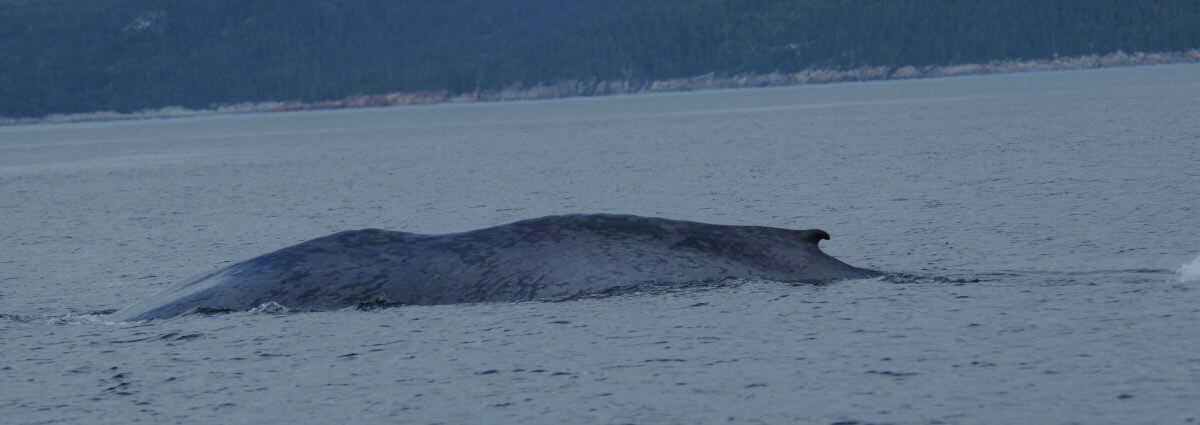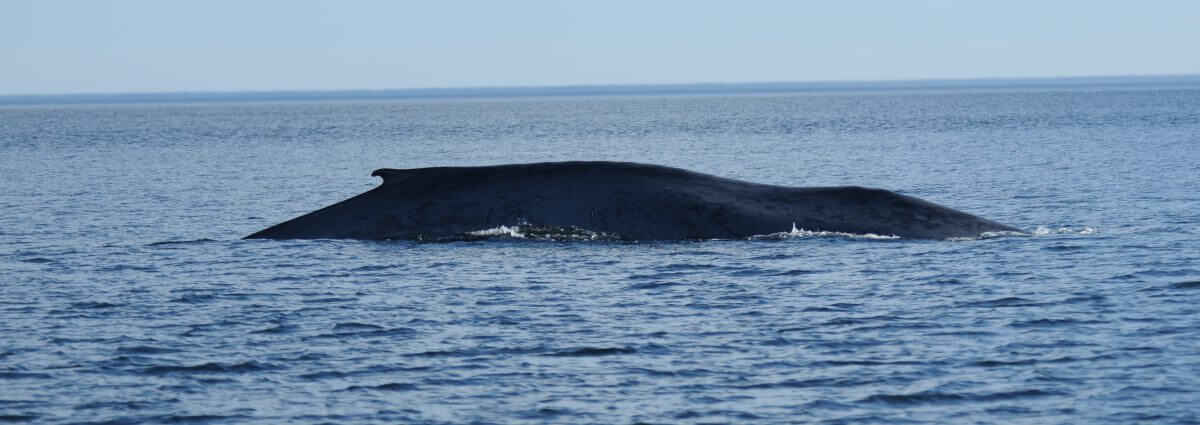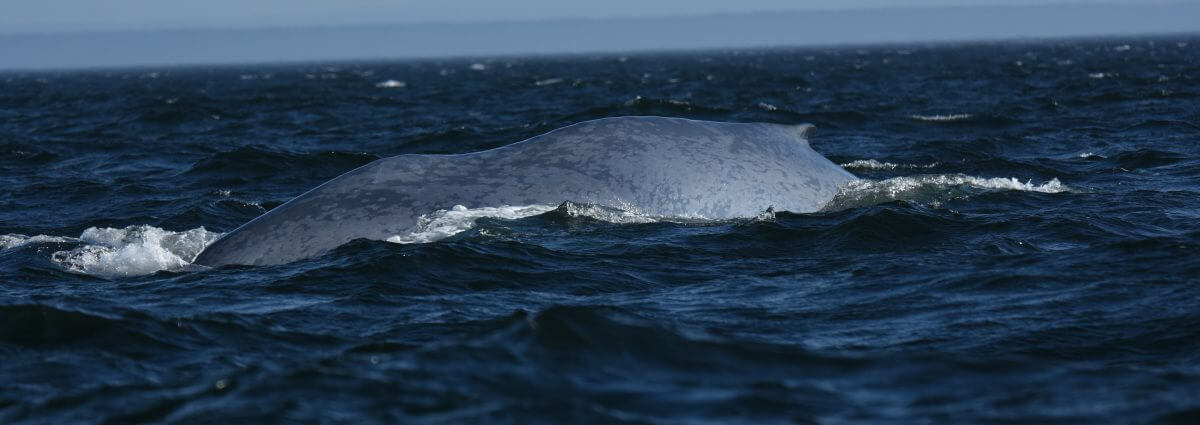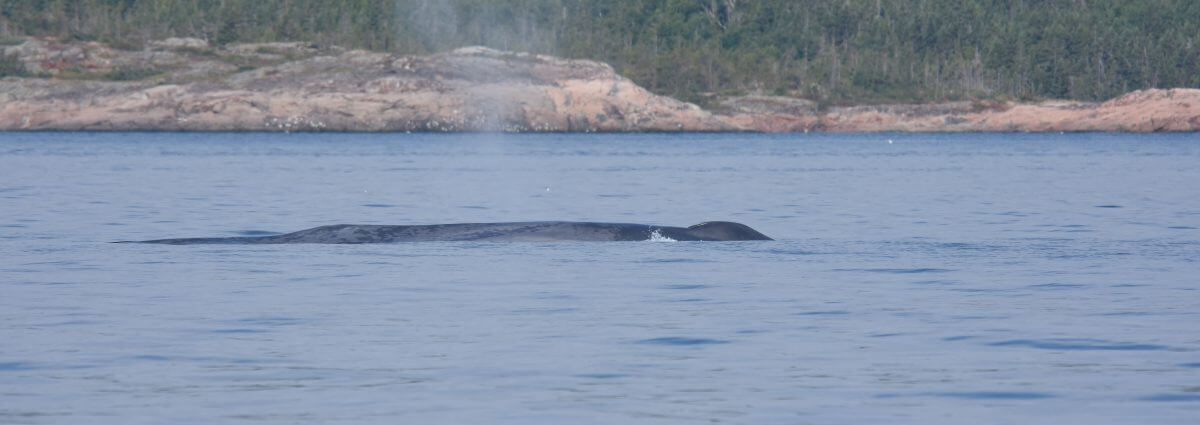Chameau
Blue Whale


-
ID number
B103
-
Sex
Female
-
Year of birth
Unknown
-
Known Since
1991
Distinctive traits
This female is recognizable at first glance. Due to lordosis, the pronounced deformity of her spine creates a depression topped by two humps reminiscent of a camel’s silhouette. It is this mark that gave her her name.
Observations history in the Estuary
Years in which the animal was not observed Years in which the animal was observed
Latest news from the publications Portrait de baleines
In August 2022, the renowned Chameau delighted many when it emerged from the rough waters of the St. Lawrence Estuary, opposite Cap de Bon-Désir. Not seen since 2017, this blue whale is one of the most easily identifiable of its species, as it has a rather pronounced lordosis on its back. This deformity gives the impression that it has two humps, like the famous desert animal. Some even thought they were seeing double when B103 came up to breathe at the surface during its first sighting in 1991: however, it was one and the same individual!
A biopsy performed in 1994 by the Mingan Island Cetacean Study (MICS) confirmed Chameau’s sex—it is a female! A few years later, in 2002, a calf was spotted alongside her. The same calf was swimming in Gaspé waters in 2011, making this whale the first ever to be rephotographed after its first year of life in the St. Lawrence.
Endangered and facing several threats, blue whales are protected by several regulations, including the requirement to keep a distance of 400 meters between the animal and any boat.
The famous Chameau (B103) is back! Recognizable at first glance, this female suffers from a lordosis-like deformity characterized by a pronounced inward-curving spine. She owes her peculiar nickname to the curious profile of the depression in her back, in front of her dorsal fin; seeming to stand there are two humps that recall the fat reserves of a camel.
Within the Marine Park, a minimum distance of 400 metres must be maintained between boats and blue whales. This precise figure – far from having been established at random – was determined by scientific monitoring that demonstrated the disturbance caused by boats to blue whales.
A study published this year in the journal Endangered Species Research by Véronique Lesage et al. (Fisheries and Oceans Canada and the Rimouski Institute of Ocean Sciences) indicates that when a vessel is near a blue whale, the animal spends less time at the surface, abbreviates its breathing sequence and makes shorter deep dives, especially at distances of less than 400 m, although the impact of this proximity can be observed up to 1,000 m away. Thus, if the blue whale has not taken the time to refresh its oxygen reserves at the surface because of watercraft that are too close, its dives will consequently be briefer and it will feed less. “The blue whale is particularly sensitive to the presence of boats around it,” says Véronique Lesage, lead author of the study. Hence the relevance of implementing the regulations in place today, and the importance of complying with them out of respect for this endangered giant.
Affected by a lordosis-type deformity, this blue whale has a remarkable silhouette, reminiscent of a camel or a sea serpent. Other blue whales in the St. Lawrence may also have deformed contours, but the speckled blue and gray color pattern allows for certain identification of the blue whale. A biopsy performed in 1994 revealed that she is a female.
Chameau is one of the blue whales that regularly visit the estuary, but she has also been photographed in Gaspésie. In 2002, she was spotted with a calf off the coast of Portneuf-sur-Mer: this was precious news, since in 35 years of working with this species in the estuary and Gulf of St. Lawrence, MICS has only recorded about 20 mothers accompanied by calves. Chameau’s case is all the more rare because in 2011, her calf was seen again, this time in the Gaspé Peninsula. In the St. Lawrence, this was the first time a blue whale calf had been photographed again after its first year of life, whereas this is quite common for the blue whale population studied in Baja California.
Chameau has been seen from time to time since July 31, and most recently on August 27, when she was spotted in the fog. So far this year, at least 12 different blue whales have been recorded by GREMM in the Saguenay-St. Lawrence Marine Park.
Classified as “endangered,” the North Atlantic blue whale is mainly studied in the St. Lawrence, which offers exceptional feeding conditions: currents, bathymetry, and tides cause significant accumulations of krill, the main prey of this giant, in certain areas. In the marine park, boats must remain 400 m away from blue whales to better protect them.
Chameau is a blue whale whose back problems have given her a silhouette worthy of the desert’s mounts,” someone wrote in a moment of inspiration.
Chameau is the most famous blue whale in the estuary. Her code name is B103 (MICS catalog). She is a female known since 1991 and has been seen every year since then. She is recognizable by the deep depression on her back, which gives the impression that two whales are following each other. When the GREMM team first encountered Chameau, the captain said she wanted to go and observe the pair there, but the pair turned out to be a single individual. Chameau has almost always been observed in the estuary. In July 2000, the MICS team photographed her in the Gaspé Peninsula for the first time, off the coast of Rivière-au-Renard.
Last year, in 2002, she arrived in the estuary for the first time with a calf. She became the twelfth female blue whale photographed with a calf in the St. Lawrence. A select club of females! Observed alone in May 2002, it is believed that the calf was probably born in June. This was an unusual case, since blue whales generally give birth between December and February. Calves observed here are therefore usually close to weaning, as nursing lasts about seven months. Towards the end of the season, the calf was no longer seen. Since it was not old enough to be weaned, there was considerable concern that it would not be seen again near its mother. It is still unknown whether it survived.
Chameau is back this year. She was observed last week in the area between Les Escoumins and Forestville.




